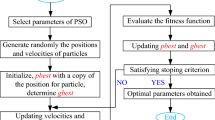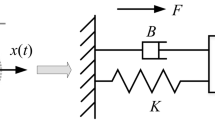Abstract
Isolating the sensitive equipment from vibrating base or the foundation from machinery vibration is of practical importance in a number of engineering fields. With the development of the vibration control techniques and increasing requirements for the higher-performance vibration isolation in industry and everyday life, active vibration isolation exhibits the best performances. In this paper, active vibration isolation reducing vibration transmitted from vibrating base to sensitive equipment and from machinery to foundation was investigated. Controller as static output feedback was considered to design components of active isolation system. An active control is provided by using H ∞ control criteria to design this controller. This criterion is presented as a cost function and then optimized by Particle Swarm Optimization (PSO) algorithm. The approach is validated using numerical simulation. Results show that this static output feedback H ∞ controller using PSO algorithm can get good performance to reduce the effect of unwanted vibration and disturbances.
Similar content being viewed by others
References
Hansen CH, Snyder SD (1997) Active control of noise and vibration. Chapman and Hall, London. ISBN 0-419-19390-1 (Chapter 12)
Crede CE (1995) Theory of vibration isolation. In: Harris CM (ed) Shock and vibration handbook. McGraw-Hill, New York (Chapter 30)
Ungar EE (1992) Vibration isolation. In: Beranek L, Ver IL (eds) Noise and vibration control engineering. Wiley, Chichester (Chapter 11)
Karnopp D (1995) Active and semi-active vibration isolation. J Mech Des 117:177–185
Suhardjo J, Spencer BF Jr, Sain MK (1990) Feedback–feedforward control of structures under seismic excitation. Struct Saf 8:69–89
Haddad WM, Hyland DC, Razavi A (1999) Active vibration isolation of multi-degree of freedom systems. J Vib Control 5:577–589
Hyde TT, Anderson EH (1996) Actuator with built-in viscous damping for isolation and structural control. AIAA J 34(1):129–135
Sciulli D, Inman DJ (2000) Isolation design for fully flexible systems. J Intell Mater Syst Struct 10(10):813–824
Toscano R (2007) H 2/H ∞ robust static output feedback control design without solving linear matrix inequalities. J Dyn Syst Meas Control 129(6):860–866
Fuller CR, Elliot SJ, Nelson PA (1996) Active control of vibration. Academic Press, London
Beard MJ, Von Flotow AH, Schubert DW (1994) A practical product implementation of an active/passive vibration isolation system. In: Proceedings of IUTAM symposium on the active control of vibration, University of Bath, UK, pp 101–108
Serrand M, Elliott SJ (2000) Multi channel feedback control for the isolation of base-excited vibration. J Sound Vib 234(4):681–704
Kim SM, Elliott SJ, Brennan MJ (2001) Decentralized control for multichannel active vibration isolation. IEEE Trans Control Syst Technol 9(1):93–100
Huang X, Elliott SJ, Brennan MJ (2003) Active isolation of a flexible structure from base vibration. J Sound Vib 263:357–376
Preumont A (2002) Vibration control of active structures, 2nd edn. Kluwer Academic Publishers, Dordrecht
Preumont A, Francois A, De Man P, Piefort V (2003) Spatial filters in structural control. J Sound Vib 265:61–79
Muller T, Hurlebaus S, Stobener U, Gaul L (2005) Modeling and control of an active vibration isolation system. In: Proceedings of the international modal analysis conference IMAC, Orlando, USA
Beadle BM, Hurlebaus S, Stobener U, Gaul L (2005) Modeling and parameter identification of an anti-vibration system. In: Proceedings of SPIE: smart structures and structural health monitoring. SPIE, Bellingham
Eberhart RC, Kennedy J (1995) A new optimizer using particle swarm theory. In: Proceedings of the sixth international symposium on micro machine and human science. Springer, Berlin, pp 39–43
Kennedy J, Eberhart RC, Shi Y (2001) Swarm intelligence. Morgan Kaufmann, San Mateo
Schutte JF, Groenwold AA (2005) A study of global optimization using particle swarms. J Glob Optim 31:93–108
Skogestad S, Postlethwaite I (2005) Multivariable feedback control: analysis and design, 2nd edn. Wiley-Interscience, New York
Poli R, Kennedy J, Blackwell T (2007) Particle swarm optimization: an overview. Swarm Intell 1(1):33–57
Olariu S, Zomaya AY (2006) Handbook of bioinspired algorithms and applications. Taylor & Francis, London
Nedjah N, Mecedo Mourelle L (2006) Swarm intelligent systems. Springer, Berlin
Mendes R, Kennedy J, Neves J (2004) The fully informed particle swarm: simpler, maybe better. IEEE Trans Evol Comput 8(3):204–210
Coello Coello CA, Pulido GT, Lechuga MS (2004) Handling multiple objectives with particle swarm optimization. IEEE Trans Evol Comput 8(3):256–279
Author information
Authors and Affiliations
Corresponding author
Rights and permissions
About this article
Cite this article
Farshidianfar, A., Saghafi, A., Kalami, S.M. et al. Active vibration isolation of machinery and sensitive equipment using H ∞ control criterion and particle swarm optimization method. Meccanica 47, 437–453 (2012). https://doi.org/10.1007/s11012-011-9451-z
Received:
Accepted:
Published:
Issue Date:
DOI: https://doi.org/10.1007/s11012-011-9451-z




